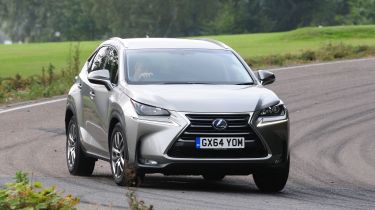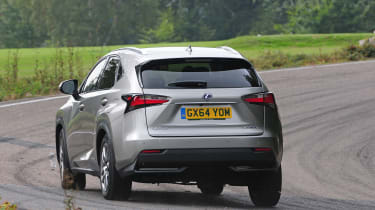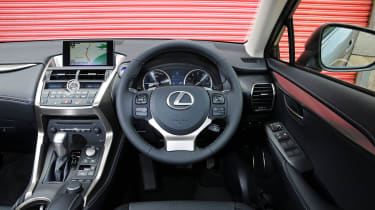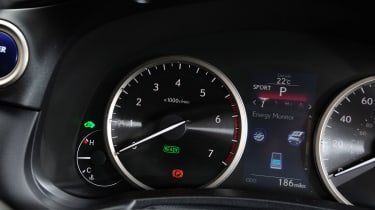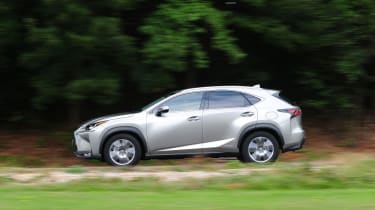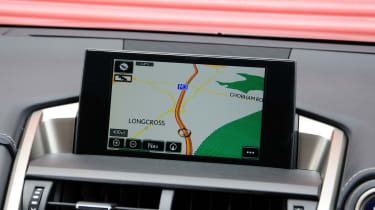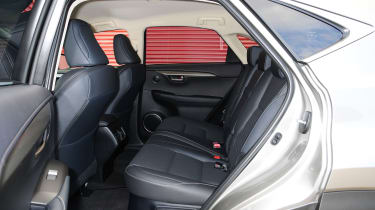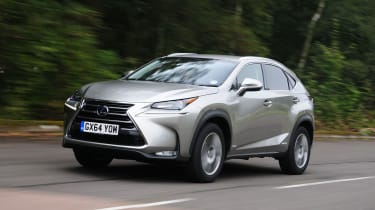Lexus NX (2014-2021) review
The Lexus NX has distinctive styling and a classy, well built cabin, although the driving experience could be better

Featuring bold styling, an upmarket interior and the option of a hi-tech hybrid drivetrain, the NX certainly stands out from the crowd. The quality on show is impressive, with plush materials and soft-touch surfaces throughout.
However, unlike its rivals in this market, the NX is only available with a petrol/electric hybrid drivetrain – there is no diesel option whatsoever, while the conventional petrol NX 200t is no longer available to order. This is the case elsewhere in the Lexus range, and it has its pros and cons.
On paper, the hybrid NX has very low emissions, plus it’s whisper quiet around town and can even run on battery power alone for a couple of miles. However, if you cover higher mileages, a diesel engine would deliver better real-world economy.
About the Lexus NX
Lexus introduced the NX in 2014, so it has been around a while and an all-new NX replacement has already been revealed. The model sits below the larger RX in the company’s range, and goes up against premium SUVs such as the BMW X3, Audi Q5, Volvo XC60 and Range Rover Evoque.
Under its eye-catching exterior, the NX hybrid uses the same combination of a 2.5-litre four-cylinder petrol engine and an electric motor as the Lexus IS 300h saloon. All variants come with a CVT automatic transmission.
Used - available now
Equipment is very generous, and there are only three trim levels in the current line-up which runs from NX via F SPORT to Takumi. The NX grade is available with front- or four-wheel drive, while the others are 4x4 only. You can spot the NX FWD by its 17-inch alloy wheels, as all the rest come with 18-inch alloys.
Entry models feature an 8-inch display screen with Apple CarPlay and Android Auto, plus dual-zone aircon and reversing camera, rain-sensing wipers and a full set of LED lights as standard, including sequential indicators. The NX F SPORT comes with a bigger 10.3-inch screen, sports suspension, blind spot monitoring and a series of more aggressive styling tweaks including a blacked-out grille and mirror casings. The NX Takumi flagship version gets upgraded leather upholstery, a 14-speaker sound system, 360-degree cameras, ventilated/heated seats and a Head-Up Display as highlights on a lavish spec list.
A 2017 facelift brought about subtle, rather than dramatic changes to the NX, with tweaked suspension, extra safety kit and an updated infotainment system. Facelifted cars also feature a reworked grille and headlights.
The NX’s appeal lies in its space-age styling and the luxury image of the Lexus brand, but the SUV is also impeccably refined on the move, plus you get a lot of standard equipment for your money, with prices that put more expensive rivals to shame.
However, there’s no diesel engine, and although the hybrid versions have low CO2 emissions for a car of this size, they’re more appropriate for lower-mileage drivers, as motorway use will see economy take a hit. That said, low CO2 figures will help this SUV appeal to company car drivers, as it cuts their annual Benefit-in-Kind tax liability - although pricier plug-in hybrids offered by rivals do much better still.
Engines, performance and drive
As with the styling, the NX’s driving experience is an acquired taste. The hybrid version in particular comes into its own at low speeds because it’s whisper quiet. That isn’t entirely the drivetrain’s doing, as the cabin is very well insulated, so there’s little in the way of wind and road noise at higher speeds.
In the NX 300h, the combination of the hybrid system and the CVT automatic gearbox provides a relaxing yet intensely frustrating ride. For instance, while the Lexus will glide around town in near-silent electric mode if you drive steadily, the battery’s range of around a mile looks poor compared to more modern plug-in hybrid models.
The transmission really lets this car down. If you need to accelerate in a hurry, the CVT auto is quite slow to react and makes the engine rev high, which is really noisy. The same thing happens when accelerating up a long motorway incline, meaning you hear a drone from the engine, which counteracts the quiet nature of the rest of the car.
The conventional - and now discontinued - NX 200t 2.0-litre petrol model has a six-speed automatic gearbox, which is an improvement on the hybrid’s CVT. However, it still isn’t as smooth or responsive as the eight-speed gearbox in the BMW X3, for example. That means the petrol version doesn’t feel as fast as the 0-62mph time of 7.1 seconds suggests.
The rest of the NX driving experience is something of a mixed bag. While the ride is comfortable on the motorway, the suspension feels firm around town and the light controls deliver very little feedback. The NX also lacks the composure and grip of rivals such as the BMW X3 and Range Rover Evoque.
With the exception of the entry-level NX 300h SE model, all versions have four-wheel drive. Despite this, off-road ability is limited. Unlike rival systems, the NX’s four-wheel drive can’t be engaged permanently and there are no driving aids like hill descent control to help tackle tricky surfaces. Most 4x4 competitors offer a range of clever technology to help here.
Engines, 0-60 acceleration and top speed
The NX 300h hybrid model’s forte is low-speed town driving, and if you’re gentle with the accelerator, it can crawl through most stop-start traffic in eerie silence. It never feels particularly responsive, though, as the NX’s rate of acceleration doesn’t match the noise the engine makes as the CVT holds it at high revs.
On top of this, the Lexus’ ability to travel only one mile at up to 30mph on electric power looks a little old hat compared to more modern plug-in hybrid models.
The older petrol-only NX 200t offers a more conventional driving experience. Its combination of 235bhp 2.0-litre turbocharged petrol engine and regular six-speed automatic gearbox delivers strong acceleration and more relaxed cruising, particularly when overtaking or tackling steep motorway inclines. If you want an NX 200t you'll have to hunt through the second-hand market or ask a Lexus dealer source one through approved-used stock - the company stopped selling the NX 200t in order to concentrate on the more popular hybrid model.
MPG, CO2 and Running Costs
Unlike rival manufacturers, Lexus doesn’t offer the NX with a diesel engine. Yet on paper, the hybrid models promise impressive fuel economy from an SUV of this size, with up to 39.7mpg from the NX FWD claimed under latest WTLP ‘combined’ driving figures.
However, if you’re a press-on driver doing lots of motorway miles, the combination of the CVT gearbox and a thirsty 2.5-litre petrol engine means consumption can suffer. Only if the hybrid NX is driven in urban areas at relatively low speeds – to make use of the battery – can owners expect to deliver good results and better diesel rivals.
CO2 emissions of 161 - 175g/km under the latest WTLP measures aren’t particularly flattering in the face of the much lower CO2 low numbers recorded by plug-in hybrid SUV rivals, and business users can expect to pay as much company car tax as drivers of non-hybrid alternatives at the top 37 per cent Benefit-in-Kind rate.
VED or road tax rates are not cheap either, with a first year charge of £885 for some models, while you’ll also have to factor in the hefty annual luxury car tax of £480 per year for the following five years if your invoice price goes above £40,000 - so that includes all F SPORT and Takumi versions.
Insurance groups
For the NX 300h hybrids, insurance ranges from group 29 for the entry-level S model to group 33 for the top-spec Premier. The petrol-only NX 200t sits in insurance group 38. The Lexus is about on par with the Volvo XC60 in this respect. It’s cheaper to insure than the BMW X3, which runs from group 30 to group 43, although annual premiums are likely to be lower for the Audi Q5, which spans groups 22 to 32.
Depreciation
Models from prestige brands generally hold on to their value well; large, luxury 4x4s sometimes less so – and that means the NX’s resistance to depreciation is mixed. Its big problem here is its main rivals in the class: demand for the BMW X3 and Audi Q5 is much stronger, and these models tend to retain much more of their price as a result.
Interior, design and technology
The Lexus isn’t likely styled to suit all tastes, but there’s no denying that its daring design attracts attention – it’s very different to the majority of more sedate models in the class. It has a bold mix of sharp creases, curves and chunky SUV styling cues.
All versions get alloy wheels and LED dipped beam headlamps, while SE models add roof rails and Luxury and flagship Premier versions are set apart by smarter silver trim inserts. Yet although the NX looks striking from some angles, its busy lines can also be a little jarring, so it’s very much a matter of personal taste.
Inside, the car is a little more conventional, as the angular theme is limited to the raised climate control panel. In typically Lexus fashion, the materials are of a good quality and everything feels well built. There are some nice touches including a portable vanity mirror on the back of the lid for the middle storage bin, plus a new touchpad control for the infotainment screen.
The NX's 2017 facelift ushered in some subtle stylisitic changes, including new headlights, a revised front grille and some new alloy wheel designs. Given the NX looks more striking than the vast majority of SUVs in the class, Lexus' subtle approach to its update is understandable, though.
Sat-nav, stereo and infotainment
One of the NX’s strong suits is its generous standard equipment. Even entry-level S models include features such as dual-zone climate control, a DAB radio and a USB music connection, as well as Bluetooth and parking aids – and the list of kit only gets longer as you move further up the range. Even so, only top-spec Premium versions come with sat-nav as standard; it remains an option for models lower down the range.
Go for an F Sport-spec NX or above, and you get a neat wireless smartphone charger housed in the lidded armrest between the driver and front seat passenger.
The new touchpad controlling the infotainment screen looks good and is easier to use than versions on older Lexus models. However, it still isn’t quite as accurate or intuitive as the Audi MMI, BMW iDrive or Mercedes COMAND cabin control systems. The 2017 facelift saw the NX's infotainment screen grow from seven to 10.3 inches, though this did little to ease progress through its maze of menus and confusing graphics.
Practicality, comfort and boot space
As you’d expect from a mid-sized SUV, the Lexus NX features jacked-up suspension and offers a high seating position, so drivers get a good view of the road ahead. There’s also plenty of adjustment in the driver’s seat and steering wheel.
Elsewhere in the cabin, you’ll find lots of useful storage, including some large door bins, a cooled glovebox and a lidded cubby between the front seats. As Lexus includes a button-operated electric handbrake as standard, it has also freed up space on the centre console for a pair of large cup-holders.
Size
The NX is 4,630mm long, 1,845mm wide and 1,645mm tall. That makes it almost exactly as long as the Audi Q5, albeit a little slimmer and lower, yet smaller than the BMW X3 in every respect.
Leg room, head room & passenger space
It’s a strict five-seater, but thanks to the sloping roofline, occupants in the back of the NX don’t get as much headroom as in an Audi Q5 or BMW X3. There’s a decent amount of legroom, though, plus because the floor is almost completely flat, passengers sitting in the middle of the rear bench will be as comfortable as those in the outer two seats.
Boot
Boot capacity stands at a rather cramped 475 litres, although that can be extended to 1,520 litres by lowering the split-folding rear seat. This is often par for the course with hybrids, as the batteries eat into the boot space – and it leaves the Lexus NX trailing key rivals like the Audi Q5, BMW X3 and Volvo XC60 for practicality. The only exception is the Range Rover Evoque, which serves up 420 litres of luggage room with its rear seats in place.
The NX stands out with a usefully wide boot opening and a totally flat load area, while F Sport models and above feature a powered tailgate. However, the towing capacity is lower than you’d expect in this class, at 1,500kg across the range. That’s because the Lexus is only offered with petrol or hybrid power; most rival SUVs with torquey diesel engines will have towing limits of 2,000kg and beyond.
Reliability and Safety
If the Auto Express Driver Power 2020 satisfaction survey is anything to go by, you can’t do much better than a Lexus which topped the tables as the best manufacturer for customer satisfaction. When scored only for reliability the NX ranked 14th out of 75 cars, behind the Lexus RX at 4th, the Lexus CT at 5th and the Lexus IS at 11th.
The NX's safety credentials are decent too, as it scored a full five stars when it was crash tested by Euro NCAP, thanks in part to the inclusion of eight airbags, stability control and LED headlamps as standard.
Warranty
Although Lexus still provides a standard three-year/60,000-mile warranty for all of its vehicles, it now also offers the opportunity to extend this cover to a ten-year/100,000-mile manufacturer warranty through its 'Lexus Relax' programme. An extra 12-months of cover is included every time you service your car at an official Lexus Centre, up until the quoted ten-year/100,000-mile cap.
Servicing
Lexus is transparent with its servicing costs – they’re all publically available. Perhaps not surprisingly for a premium brand, prices are slightly higher than average, but it’s good to know what you’re getting in advance, and the NX still works out as one of the cheaper models in its class to maintain.
Visit our Find a Car service for the latest deals on the Lexus NX or check our free car valuation tool for the value of a specific model...
